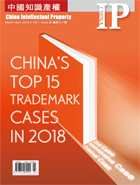Regarding the relevant data on IP cases in 2018, Lin Guanghai, Deputy Chief Judge of Civil Adjudication Tribunal No.3 (IPR Division) of the Supreme People’s Court (SPC) said on the 9th China IP International Annual Forum that the courts in China received a total of 305,000 IP cases for first instance and 292,000 cases were adjudicated in 2018, with an increase of 40.7% and 41.2% respectively compared with 2017. Among the new cases, there were 283,000 civil cases, 13,000 administrative cases and 8,600 criminal cases. The civil cases include 195,000 copyright cases, 52,000 trademark cases, 22,000 patent cases, and 14,000 other types. At the beginning of 2019, Civil Adjudication Tribunal No.3 (IPR Division) of SPC was set up as a permanent establishment of SPC, responsible for handling more technical civil cases such as patent cases, and administrative second instance cases across the country. At the same time, SPC also approved the establishment of cross-regional IP Court in eight municipalities including Tianjin, Zhengzhou, Changsha, Xi'an , Nanchang, Changchun and Lanzhou in 2018. At present, the local courts across country have established 19 IP courts with inter-regional jurisdiction.
In the same period, the IP Courts in Beijing, Shanghai and Guangzhou accepted 30,899 first-instance and second-instance cases in total, and 25,737 cases were settled. Beijing Intellectual Property Court accepted 1,517 patent administrative cases, with a year-on-year growth of 30.7%, and 1,007 cases were settled, with a year-on-year growth of 33.7%. 11,974 cases of trademark administrative cases were accepted, with a year-on-year growth of 40.2%, and 10,087 cases were settled, with a year-on-year increase of 53.4%.
Lin Guanghai also indicated that IP trials will play a leading role of judicial protection in a better way in 2019, including:
First, China implements the project to improve the quality of patent and carries out the reform to facilitate the trademark registration, which requires the people's court to better perform the supervisory function in the trial of the confirmation and authorization o f patent and trademark rights, and to innovate the mechanism in the trial of infringement cases in order to substantially resolve the disputes. Through trials, it is necessary to warn all parties that a patent or trademark is more than a piece of paper. Competitors cannot fight for the piece of paper unscrupulously. Through trials, we shall clearly tell people that the court is not a battlefield.
Second, t h e legislation is accelerating the systematization of the punitive damages system for IPR. The Trademark Law has already stipulated the principle of punitive damages. The Civil Code Tort Liability (Draft) and the Amendments to the Patent Law, which are currently submitted for legislative review, also stipulated punitive damages for IPR, reflecting the general aspirations of the society. This requires the judgments of the infringement compensation to change, and conform to the direction, principle and spirit of the law revision, resolutely increase the cost of infringement compensation and abusing the appealing right, and exert sufficient deterrent force.
In addition, Lin pointed out that there are still many other aspects need to be highly valued. For example, the new era requires further strengthening and improving the protection of IPR on the Internet, and protection of business secrets, building new patterns in these areas to achieve a new balance.




